Words from the President
– Ravi Kandikonda
We are pleased to present our Annual Report for the year 2011. This year marks two decades of Asha’s humble beginnings as a student action group at the University of Berkeley, California. We commemorated this at our biennial Asha Conference held at Stanford University over the Memorial Day weekend with over 70 attendees from 17 chapters around the US.
We raised over $3.5 million and spent close to $3 million. Asha chapters around the world conducted awareness and fundraising events to help support our projects. Thanks to all Asha volunteers, donors and supporters for making this a very successful year for Asha.
Bhoomiheen Sewa Samiti
Site visit report by Aparajita Durga and Srijan Chakraborty, Asha Seattle
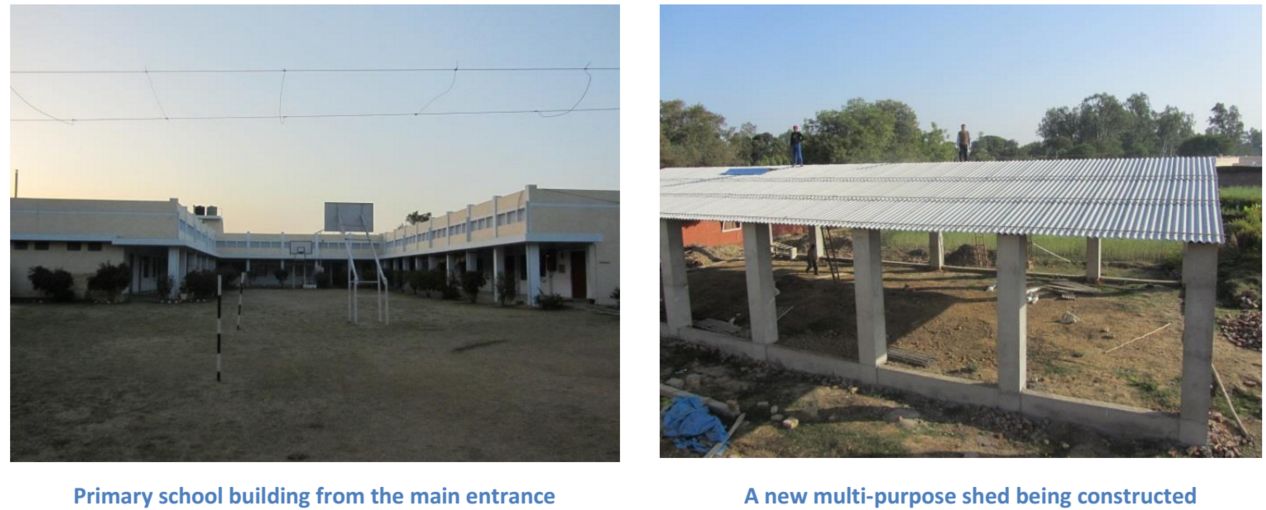
Aparajita and I visited Bhoomiheen on 11 and 12 February 2011. This was my second visit to Bhoomiheen. I had visited them four years ago.
We reached Manikpur station in the afternoon. One of the teachers and a driver were waiting for us. From there it was about an hour’s drive to Aau village where the Bhoomiheen School is located. Atarra is the nearest city and about a 10-minute drive from Aau. Lalitji greeted us when we reached the school. By the time we reached, the school was winding down for the day. Most of the students had left though most teachers were waiting for us at the entrance and greeted us. After brief chit-chat with them, we freshened up in one of the guest rooms in the main primary school building. I saw a new structure coming up near the high school building that I had not seen on my last visit. All the other buildings had been maintained fairly well.
Since the school was over, we decided to take a stroll through Aau village with one of the teachers. The village was still as segregated as it was four years ago, with different sections for different castes. As we walked through the main pathway inside the village, we crossed the localities of various castes and observed how the road was wider and the houses bigger and cleaner in the upper caste area than in the lower caste areas. Most people live in earthen houses with tiled or thatched roofs. There are some bigger houses and a couple of “pukka” multi-storied buildings with large courtyards and gates.
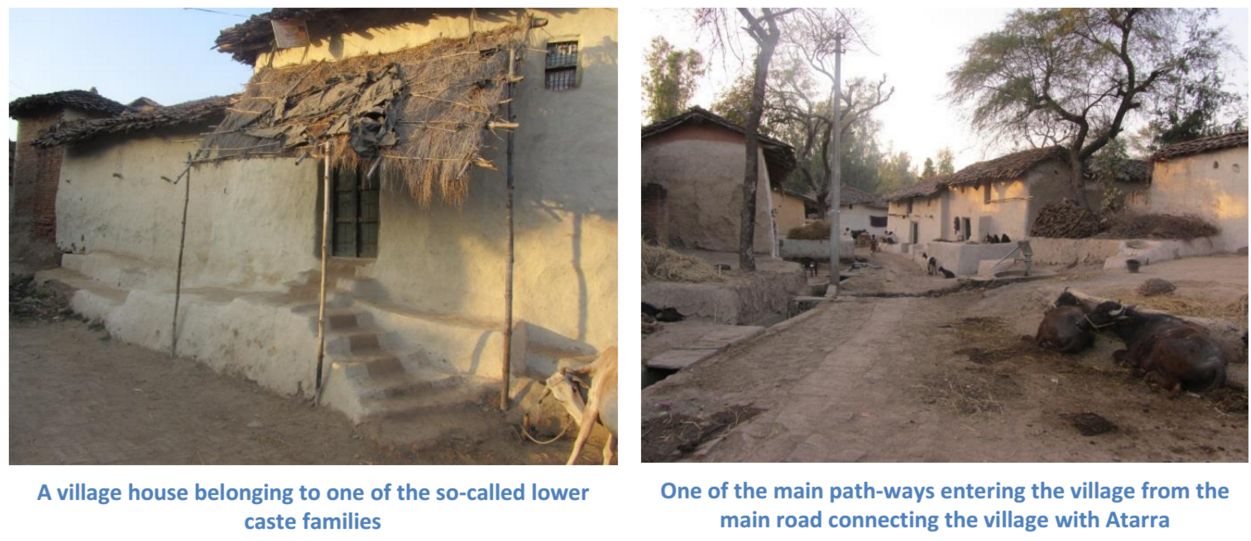
The wealth distribution reflected the feudal structure, with power concentrated in the hands of few upper caste landlords. Though some land has been distributed to lower castes, all tractors are owned by the landlords, who rent these out to other villagers. The village has electricity but not every home has electricity. There are a few small shops scattered around the village, livestock (mostly cows and bulls), haystacks, etc. In general, the village is fairly clean.
We stopped and talked to a few people. A group of girls playing outside their house told us that they attend the Bhoomiheen School and liked it there. Some were a little shy but two of them were very confident and smart while chatting with us. Apart from the regular courses, they learnt stitching in school. Aparajita was saddened to hear that like many others in the villages, they too had many brothers and sisters. The girls liked studying but did not know how much they would be able to study. After the village tour, we came back to the school. Lalitji was playing cricket with some of the students. We watched them from the roof of the primary school building and saw an amazing sunset.
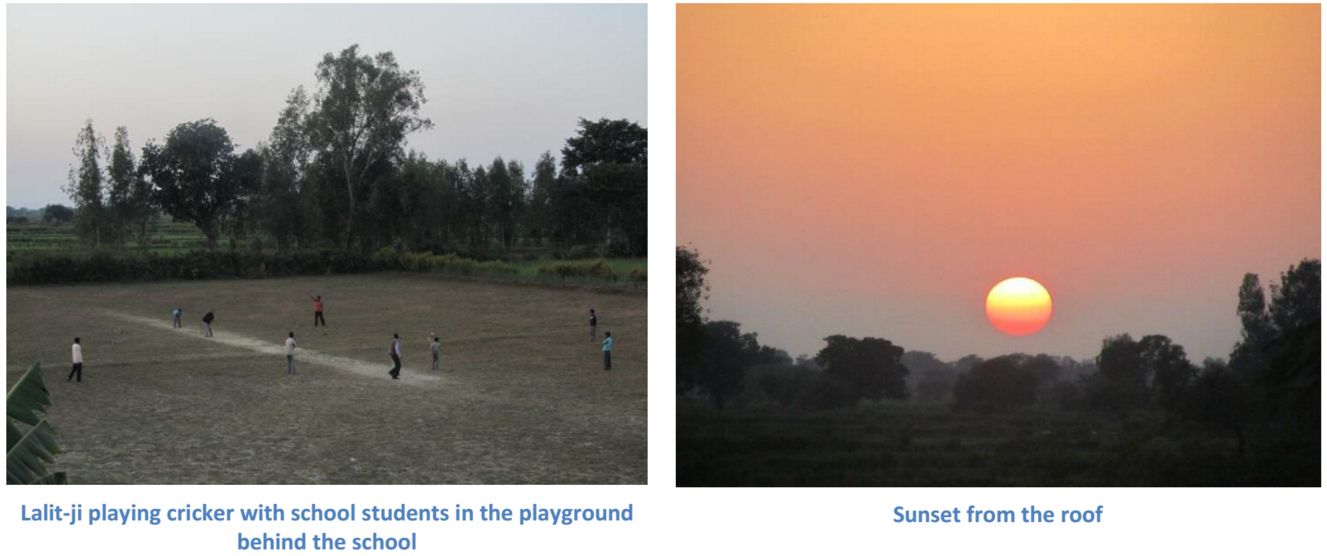
In the evening, Lalitji talked to us about the school, the teachers, challenges the school is facing and future plans. We also discussed the recent Right to Education bill and how it will likely affect the school. Lalitji was highly critical of the law the way it is enacted and the various amenities that small schools like Bhoomiheen, which have very limited resources, will have to provide.
A few students stay in the school since they come from far-off villages. We talked to them. Most of them were studying in their room. The generally do their own cooking and are quite self-sufficient. An instructor who also lives there also cooks his own food. They wake up really early, clean up and cook food for the day in the morning. There is a small kitchen and a cook. She cooked simple but great tasting fresh food and chapattis for us. Some of the vegetables were from the school farm. The cooking fuel is wood in an earthen chullah (oven).
Next day we woke up early, had breakfast and got ready before the school started. Lalitji showed us around the school’s farm. They have bought more farmland and are growing quite a diverse set of produce including many vegetables, bananas and other fruits, some lentils, sugarcane and barseem for cattle fodder.
They are trying out mushroom cultivation and built a separate structure for that. One of the instructors had trained in mushroom cultivation in Allahabad and his mushrooms were in the trial phase. Lalitji mentioned they have given samples of these mushroom and some baby-corn to a restaurant in Allahabad, who were very happy with the quality of the samples. If the arrangement works, mushrooms can be a good cash crop and growing mushroom will be added to the list of vocational courses at Bhoomiheen.
Organic farming is already part of the vocational training at the school along with TV/radio/electronics repair class, stitching class, etc. Bhoomiheen is also trying to get recognized by the National Institute of Open Schooling (NIOS), which will benefit the school and the students.
Children started pouring in long before the school started. They queued up for morning assembly, sang their morning prayer and other songs and then classes started. We walked around the school, stopping at several classrooms, talking to children and the teachers. A few teachers have been with the school for a long time and we chatted with them to hear their thoughts and concerns.
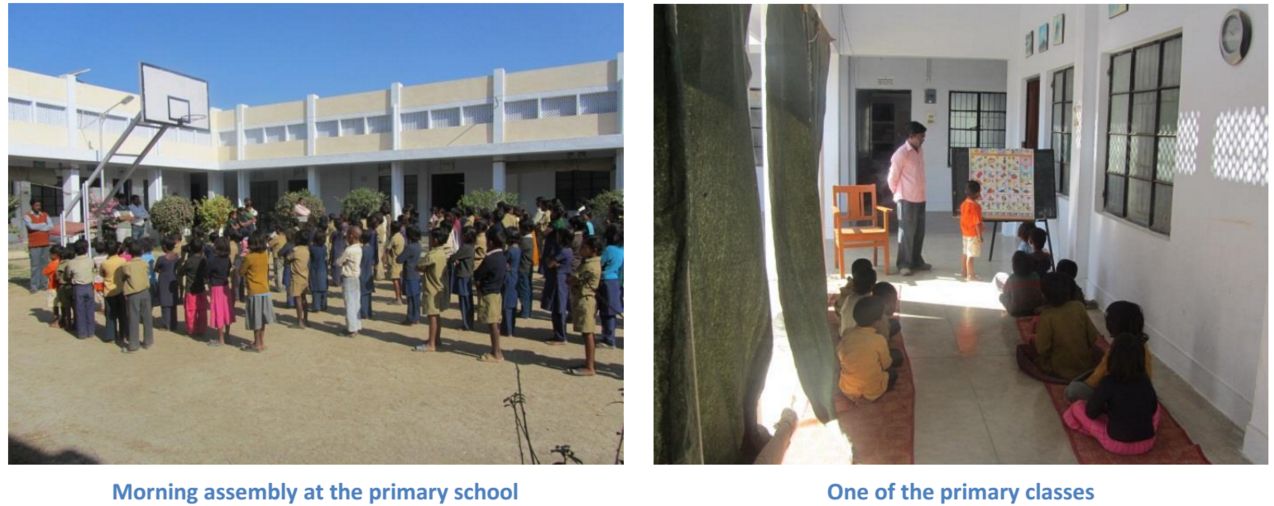
It is, for the most part, a formal school with class structure and curricula similar to most schools. However, some of the teachers have been trained in alternative teaching methodologies and they incorporate parts of those in their classes, including many teaching aids and games. They have a separate activity room-cum-library with many educational games that students are free to use for some time during a day.
We looked into a number of vocational classes and saw students engrossed in their work. Classes that teach electronics repair, water pump repair, etc. are very practical and relevant in their lives. Students in the sewing class were able to stitch their own clothes. Most of the vocational teachers are part-time and paid by the hour. According to Lalitji, these programs have increased in scope and attendance over the years and are very popular with the students.
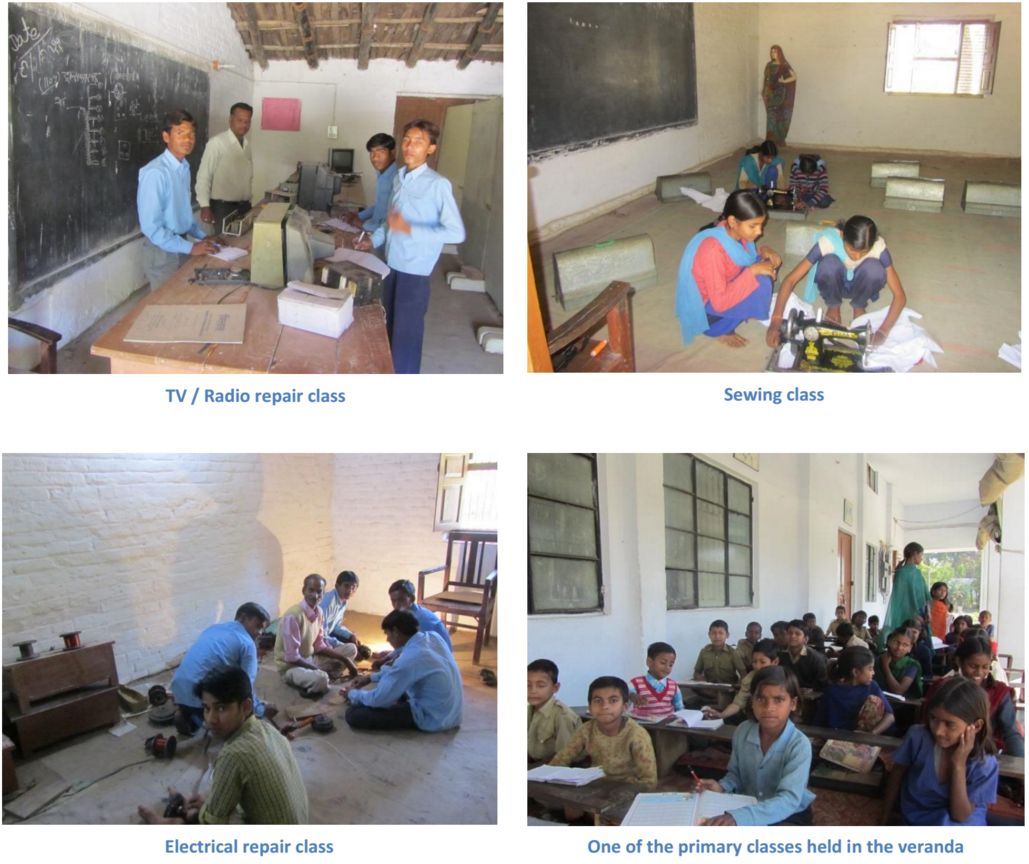
We saw the computer lab which consisted of two small classrooms with 10-15 computers in each. Most of the computers were old and the school will need to upgrade and expand. There is one computer teacher but we did not see any computer class taking place while we were there.
Very soon it was lunch and the school bell rang for lunch. The kids sat down in an orderly manner in rows with their lunch plates. Some kids served the lunch of daal, rice and a vegetable dish (Students took turns to serve). The food provided to the middle school students is funded by the government mid-day meal scheme and is substantial, whereas the primary school students get some snacks. It was very nice to see the students wash their own dishes after lunch.
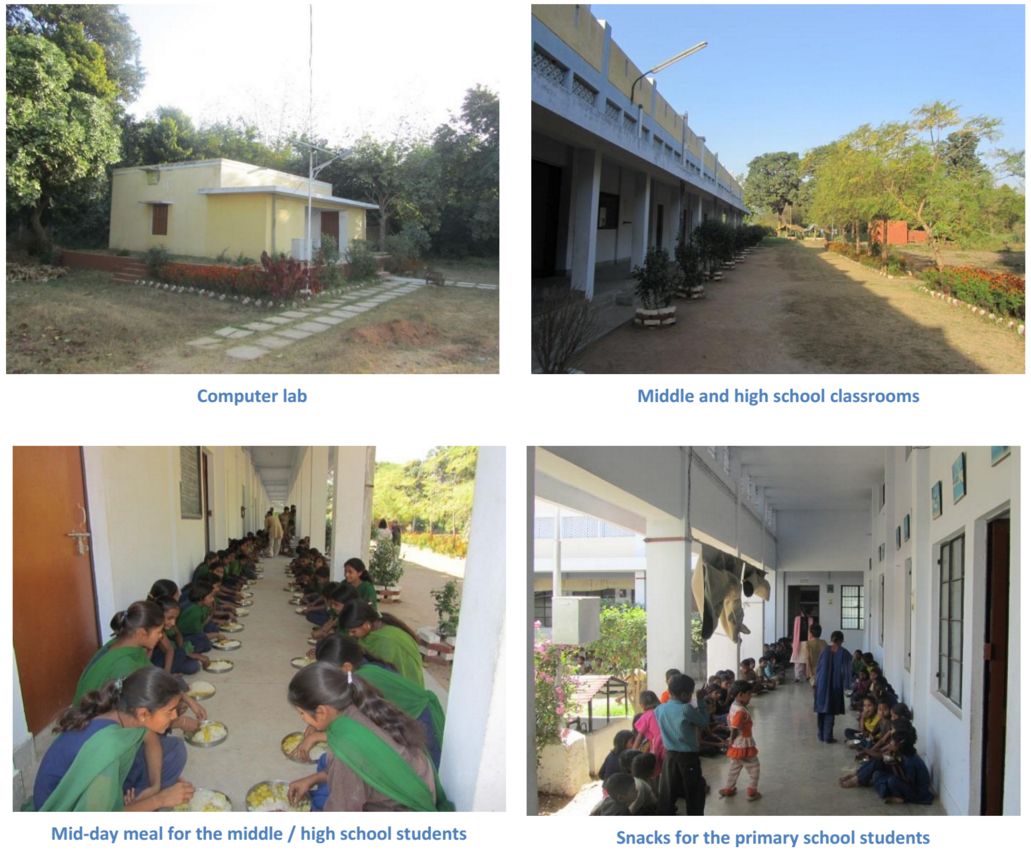
In the afternoon, the students staged some cultural programs including songs, dances and skits, for us. The cultural programs took place in the newly constructed multi-purpose shed. The entire program was quite properly set up with arrangements of music system and loudspeakers. The entire school had assembled and was eager to exhibit their talent. They were fairly confident in all their activities and seemed very confident using microphones and other instruments. A group of students enacted a nice skit. This was followed by songs and dance performances. A couple of students also took charge of taking photographs with digital cameras. Some of the teachers talked about some of the challenges the school is facing, most of which were infrastructure-related. Aparajita and I addressed the students for a few minutes each.
By the time the program ended, it was time for us to leave: We had an hour’s drive to Allahabad to catch a train. Overall we left with a very positive impression. We were very moved and inspired by the work Lalitji had done, fighting against extreme odds and bringing in hope of change in this extremely feudal and rural world. The school was functioning very well and has certainly improved over the years. The overall infrastructure has improved, more farmland has been acquired, more vocational courses have started and they are on their way to NIOS recognition. Teacher retention remains one of the top concerns since the salaries are fairly low compared to government schools. That is one reason why the primary school headmistress, whom I met in my last visit in 2007, left to join a government school. We also talked about the next rung of leadership after Lalitji, which remains a problem. Despite these challenges, the Bhoomiheen school is a source of hope and education for the children of Aau.
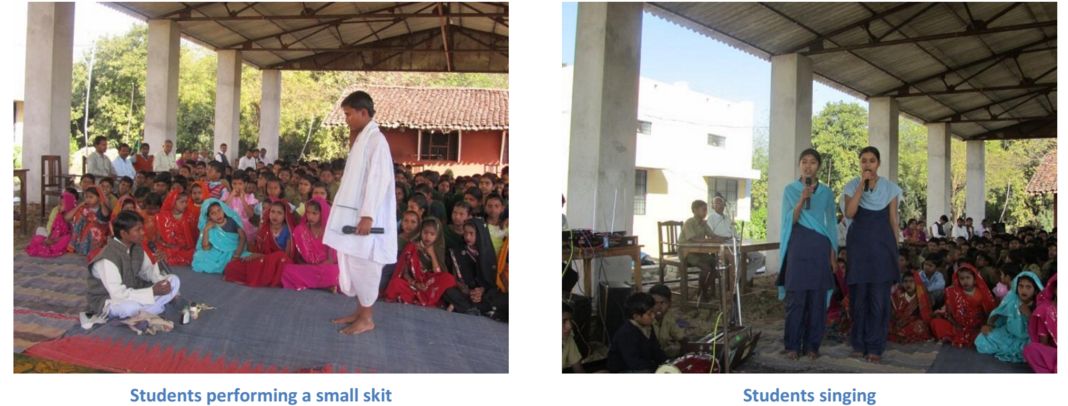
Asha 20 Conference
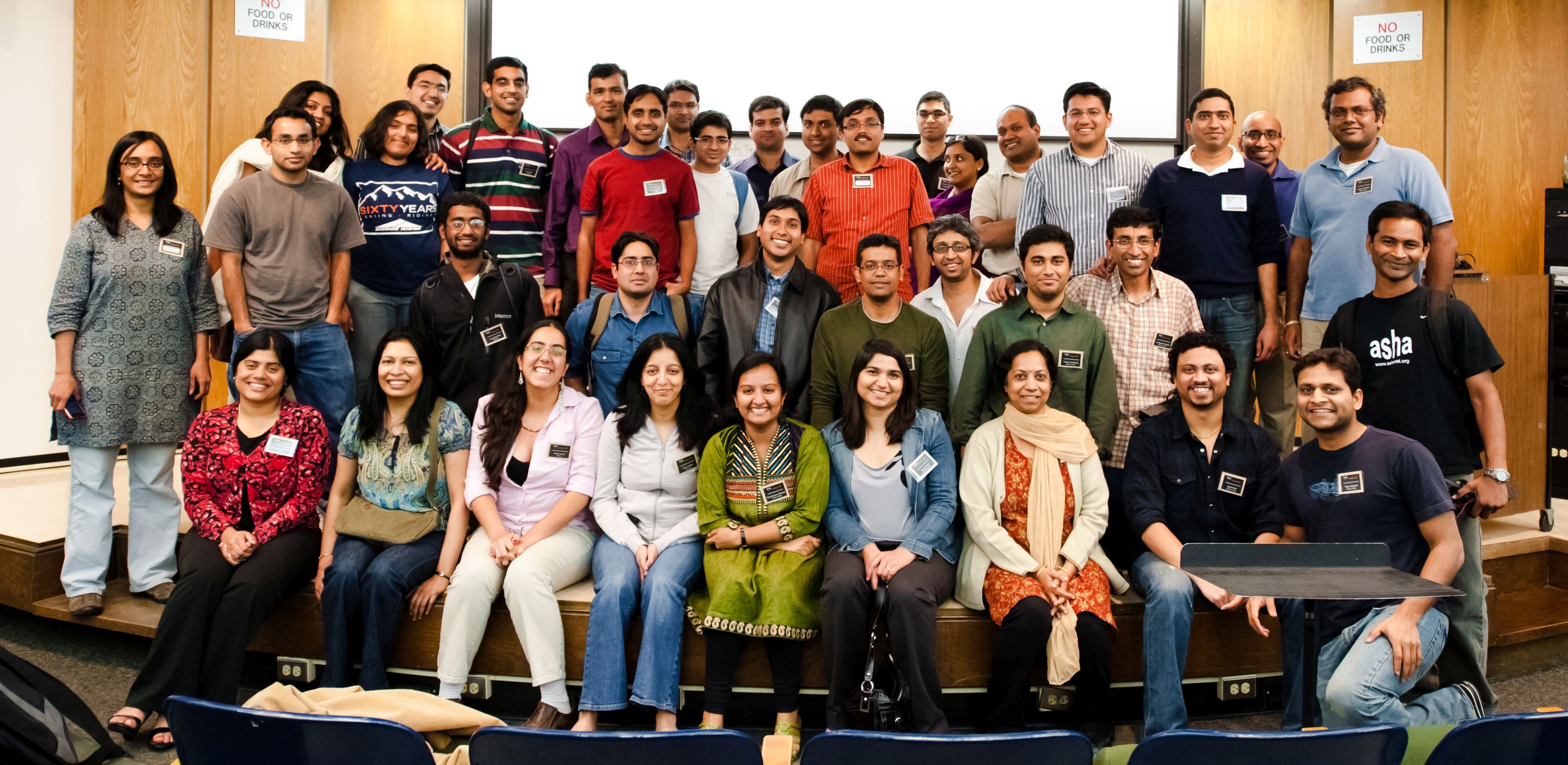
The Asha 20 conference was held over the Memorial Day weekend (28-30 May) at Stanford University. It was hosted jointly by the four Bay Area chapters, that is, Silicon Valley, Stanford, San Francisco and Berkeley. There were over 70 attendees from 17 chapters of Asha for Education in the US. This three-day conference was a good time to take stock of how far Asha had evolved in two decades and how far we have yet to go.
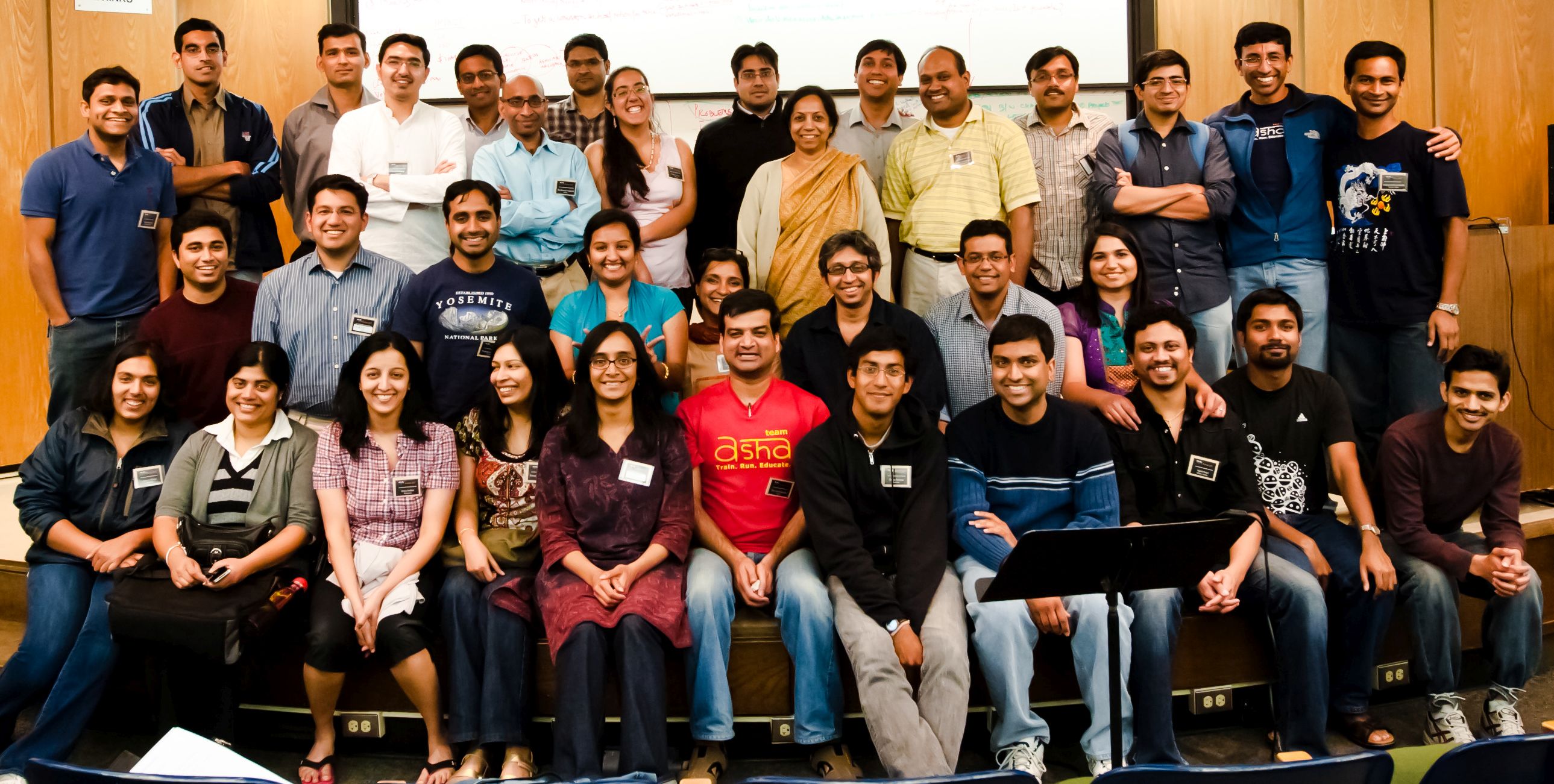
Samrudhi Microfinance Society
Devdatta Akhawe, Asha Berkeley and Sanju Kumar, Asha project partner
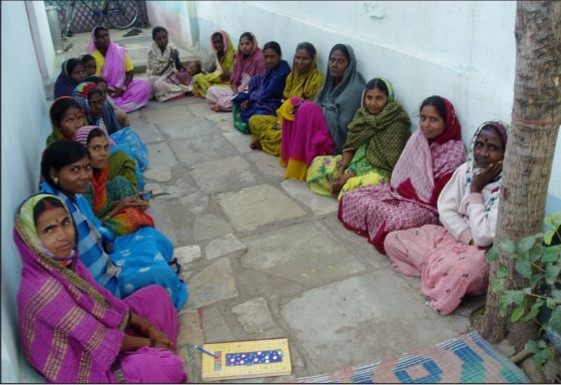
Banking in India is a luxury for the upwardly mobile. A savings account requires proof of identity and proof of residence, and the poor sometimes have neither. Financial services are essentially non-existent for the urban poor and even more so for the rural poor.
The situation is worse for credit. 87% of the poorest households do not have access to credit. If the poor can access low-interest credit during times of crisis, they can avoid falling into the debt trap. But bureaucracy and corruption often prevent them from accessing credit from banks and the government. Instead, the poor borrow from moneylenders who charge exploitative interest rates – often as high as 72%-350% per year – putting them in a debt trap. They fall into a vicious cycle of “low income, low savings, low investment.”
Yet, reliable credit, whether emergency funds to tide over a crisis or capital to start a small business, is necessary to break out of that age-old vicious cycle and begin a virtuous cycle of “injection of credit for investment, more income, more investment, more income.” One model that has achieved considerable success in most developing countries is that of a micro-finance society providing small (micro) loans to the poor with no collateral. A famous example is the Grameen Bank founded by Prof Muhammad Yunus in Bangladesh.
Samrudhi Microfinance Society is a social enterprise replicating the microcredit model for poor women in the villages and urban slums of Gulbarga district of Karnataka. It focuses on women for multiple reasons. In addition to being caregivers and providers, women are often more trustworthy. Though they are often the more marginalized, they tend to use resources more productively, ensuring the empowerment of whole families.
Samrudhi does not require any collateral and offers reasonable interest rates. For example, Devaki, a vegetable vendor, used to borrow from the local money lender at the exorbitant rate of 180% per year. Samrudhi currently offers her credit at around 20% per year, allowing her to keep more of her profits.
Samrudhi has disbursed more than ₹1.2 crore ($0.27 million) to 2,000 women. These micro loans have enabled families to have better livelihood options, increase & diversify incomes, build assets, mitigate risk, plan for the future, make choices, increase food consumption and invest in education, health, housing, water, and sanitation.
Samrudhi follows a group formation, individual lending approach. A group of 20-25 members is formed and group meetings are held weekly. Upon being a member for two successive weeks, one can apply for individually disbursed loans, with weekly installments paid at the group meeting.
Recently, Samrudhi has initiated two new projects, “Livelihood Promotion through Integrated Farming System (IFS)” and “Health & Livelihood”. The former trains farmers to maximize productivity by utilizing natural resources effectively. The latter, a low-cost sanitary napkin project, improves hygiene and provides livelihood. It enables women and girls to use sanitary napkins instead of dirty and unhygienic rags. The women making the quality sanitary napkins market these through women’s self-help groups.
Asha Berkeley has been funding the salary of Sanju Kumar, the founder and CEO of Samrudhi, for the past two years. Our main goal is to support him until Samrudhi achieves financial sustainability and is able to pay his salary without our help. We are glad to note that Samrudhi is on track to achieve this important milestone in the next 18 months. It has secured loans from financial organizations like SIDBI, Syndicate Bank and IDF.

A Mesmerizing Violin Performance
Asha Munich

On 8 October 2011, Asha Munich hosted famed Carnatic violinist Dr L Subramaniam and his son, Ambi Subramanium, at the Hilmar-Hoffmann-Saal Zentrale vom Goethe-Institut. “The Paganini of Indian Classical Music”, Padmashree Dr L Subramanium started his music career very young. Throughout his career he has been honored with numerous awards. Inspired by his father, Ambi Subramanium started mesmerizing audiences at the age of 19. A master of both western and Indian classical violin, Ambi has performed with Orchestra Nationale du Lille, Sinfonia Baltica, Philharmonica du Stadt Sibiu, Fairfax Symphony Orchestra and Leipzig Philharmonic Orchestra.
The performance, under the Lakshminarayana Global Music Festival, was a perfect father-son jugalbandi demonstrating the violin heritage of India. Through this event Asha Munich raised €6000 that is now being disbursed to various educational projects in India. The chapter also used this opportunity to display the fantastic photos taken by Felix Korts during his visit to different education projects in India.
The event was a huge success for Asha Munich in terms of fundraising and publicity.

Institute of Social Work
Site visit report by Asha Sharma, Asha Cornell
The Institute of Social Work (ISW) is an NGO based in Kolkata, West Bengal, which works to provide better opportunities to underprivileged women and children. Founded in 1978, ISW works in the greater Kolkata area on several fronts including primary and middle school education, vocational training for women and promoting awareness of social and health issues among women.
Asha Cornell supports two of ISW’s education projects: one at Barasat comprising of elementary and middle schools (Sishu Vikas Bharati and Kishore Vikas Bharati) and the other at Khidderpore where ISW runs a non-formal school and a coaching center for girls. The parents of the children served by these projects have meager incomes from vegetable vending, casual labor, rickshaw pulling, etc. More than half the children are girls.
The Schools: The Barasat school was founded in 1982 with volunteer teachers and 33 children who had dropped out of mainstream schools. Today, the school has nearly 400 children in classes from nursery to 8th grade. Besides the head of the school, there are nine teachers who teach Bengali, English, mathematics, science, history and geography. The school follows the syllabus prescribed by the West Bengal Board of Secondary Education though it is not formally affiliated with the board. Students also participate in a variety of extracurricular activities such as dance, music, recitation, sports and crafts.
In January 2011, I visited the Khidderpore school. Khidderpore is an industrial and port area on the eastern side of Kolkata. The school is located in a slum with a large Muslim population. We were greeted by Sushmita Bhattacharya, who manages day-to-day activities at the school and teaches English. From the main road, we walked down a narrow, winding lane to reach the school, which is located on the upper two stories of a three-story building.
Classes are held in small rooms and there is a basic office or staff room in an even smaller room on the second story. When we visited, there were four types of class in session, two vocational training classes in tailoring and doll-making,` a coaching class for girls and a class to prepare first-timers and dropouts for entry or reentry into regular school. The coaching class caters to about 35 girls for whom English and Bengali instruction supplements their school education. The preparatory class has 40 children, who are given basic instruction that helps them get into and stay in regular schools. The 20 girls in the vocational training classes were aged 18 and above and most of them had left the school system between 8th and 10th grades.
Talking to the three teachers present, it was apparent that it was sometimes frustrating to fight the local bias against educating girls and allowing them to work. Particularly, the families of many of the older girls in the vocational classes did not want them to work in a mixed gender environment or even outside home. The teachers were optimistic though since an increasing number of parents were sending their daughters to school, more so because tailoring allowed the girls to conform to restrictions while earning.
The school had arranged with a small doll-making business to train and employ other girls in similar situations. When I asked some of the girls about their education, I sensed a slight wistfulness. Most of them were only a few years younger than I and I wondered if they were thinking the same thing I was: Had they been born in a family like mine, their circumstances would have been very different and they would not have been there.
While the girls in the vocational training were quiet and shy, I was struck by the confidence of the girls in the coaching class. They seemed eager to do well in school and to continue their education by going to college. I was very encouraged to see their enthusiasm in the face of such difficult circumstances. The younger children were a lively bunch even when the teacher told them somewhat sternly to be quiet. They cheerfully greeted me in sing-song voices and asked me my name.
I came away from the school with mixed emotions. While it seemed clear the older girls could not aspire for careers beyond tailoring and doll-making, it was good to see that they were at least able to earn an income thanks to ISW’s efforts. With the younger children, I hoped their enthusiasm would not be dimmed by the difficulties they would inevitably face as children from poor families. When I saw the determination of the young girls in the coaching class, I felt hopeful that they would try their best against the odds.
Challenges: The children attending ISW’s schools come from economically disadvantaged families and several are also forced to supplement the family wages by working. Malnutrition is common. Domestic abuse is not uncommon but is seldom reported and children are either victims or witnesses. Since many of the parents have had little or no education, they are unable to help their children with their studies. To discourage and deal with absenteeism, ISW’s teachers visit the homes of students who have been away from class for an extended period.
Achievements: The efforts of ISW’s teachers to engage parents by holding parent-teacher meetings and by visiting the homes of absentees appears to have paid off in terms of increased attendance at the schools. Some of the graduates of the Khidderpore coaching center have gone on to attend college. In my previous visit to the Barasat school as well as this visit to Khidderpore, the children seemed very enthusiastic and happy to study. Many of them expressed the desire to study further. The teachers, most of who are from the local community, came across as being very dedicated.
Rishi Valley
Kavi Duvvoori, Asha Seattle
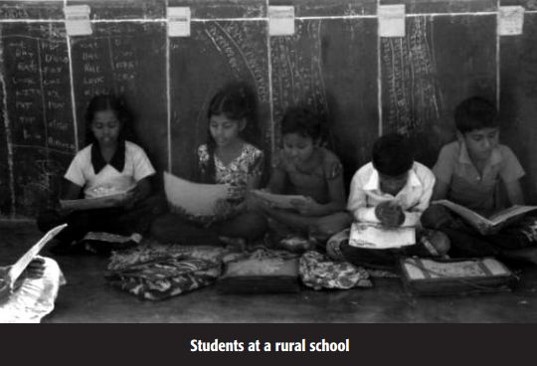
Rishi Valley is in a rural but arid region of south Andhra Pradesh, surrounded by villages subsisting on farming and cattle rearing. Rishi Valley Education Center, established in 1926, started with a school based on the teachings of the thinker Jiddu Krishnamurthy. Over time, it expanded to include a rural health center and a rural school. Along with the Andhra Pradesh government, it recently instituted a special development authority to “protect and conserve the rich and diverse environment” of an area of donated land.
Rishi Valley Institute for Educational Resources (RIVER): The rural school was started to educate children of workers at Rishi Valley School. Four nearby villages asked Rishi Valley to educate their children too. The founders felt conventional textbooks and learning material, with examples often originating from an entirely foreign urban world, lacked context for rural students. Therefore, RIVER set out to design entirely new content, relevant to rural students, and innovated to address other needs as well.
After years of experimentation, they developed an approach called “school in a box”. This is a multi-level, single-teacher, single-room approach to achieve literacy, where a single teacher in a “satellite school” teaches students. Children of varying ages and learning abilities learn together at their own pace. Older children often teach younger ones. To encourage attendance, children are fed nutritious meals at school.
The school also tries to influence students’ lives beyond classrooms. Every day, a student marks on a checklist whether she brushed her teeth, cleaned the place where she sits, tended a plant, helped another student and even played a game.
Because rural students often miss school when their families pull them out to help with farm work, the “school in a box” has ladders of cards that students can work through at their own pace and make up for lost days. The ladders are color- and animal-coded: color indicates the grade levels and animals indicate subjects and groups.
The program has been very successful, educating over 400 students with a very low dropout rate. It operates on a minimal budget, relying on the cooperation of local communities. Moreover, Rishi Valley runs 15 satellite schools and thousands of students study the RIVER curriculum. It has been translated into various languages for use in other states and is even being adapted for the Oromo people in Southern Ethiopia.
Rural Health Center: The Rishi Valley area has limited medical services. The closest advanced medical facilities are in Madanapalle with which there is a sporadic bus link. Bangalore, the city with more modern healthcare facilities, is 140 km away. In 1999, Drs Kartik and Vidya Kalyanram came to the valley from Bangalore to set up an integrated health program with comprehensive services.
The Rishi Valley Rural Health Center (RHC) now provides medical services locally. It houses a dispensary for a basic pharmacy, an X-ray machine, ultrasound is available once a week, and there is a small microbiology & pathology lab. A donation has funded a van which acts as an ambulance. RHC works on health education as well, in areas such as nutrition and diabetes. Inadequate antenatal or prenatal care is another major cause of poor health. Hence, there is a program for educating expectant parents on diets that maximize the prospect of delivery of a healthy child and reduce the complications for the mother.
Local acceptance and support for RHC are very high. While visiting, patients are interviewed in Telugu, their mother tongue. A team of 18, with 15 local support staff, are in charge of tasks such as running eye clinics in villages, administering post–op care for patients who have undergone eye surgery, supervising treatments for TB patients and dispensing medications. The technicians helping in the labs are locals trained and supervised by Drs Kartik and Vidya. RHC intends to continue this approach and plans to train more such volunteers to work in the community.
Clinic visits are charged according to patients’ incomes (as recorded on their ration cards). Typical charges are ₹18-20 (about 40 cents) where doctors in the nearby town charge five times more. The fees ensure responsible use of facilities and help support the clinic though they are waived for patients who seem unable to pay. To put this in context, 90% patients earn less than ₹2,000 ($42) a month. Sometimes villagers in critical conditions require transfer to a hospital. Dr Kartik informed us that he has created connections to get them treated at discounted rates, with RHC bearing the costs.
RHC is also engaged in research in the following areas: (i) Impact of Pesticides on Health, (ii) Rishi Valley Vascular Diseases Project (in collaboration with Monash University, Melbourne) to find factors responsible for the high prevalence of hypertension in rural India and (iii) a self-funded pilot study to study factors causing the high prevalence of diabetes in this disadvantaged rural population.
RHC has grown with the aid of internal support, self-funding and external donations. (Rishi Valley alumni provide some support through Ashe Seattle.) It operates on a shoestring budget with high efficiency and accountability. Nevertheless, there is still a great need for low-cost, quality health care of the kind that RHC provides.
Rishi Valley Special Development Authority: This project aims to conserve and protect the biodiversity of the area while developing the villages with help from the state government. The area was traditionally very drought prone and its surrounding regions are environmentally degraded, with a significantly lowered water table and extensive deforestation. The government of Andhra Pradesh gave Rishi Valley a unique special development authority to conserve the land. They have constructed water harvesting structures including percolation tanks, check-dams and bunds along 800 hectares of hillside. They have planted select fruit trees to hold the soil and have re-vegetated 150 acres of scrub forest, which provides fodder for cattle.
They have also established an herb garden and large nurseries of peepal and neem saplings and fruit trees. Saplings and herbs are given away to farmers, while their cattle feed off of the reforested areas. These activities are even more impressive given they are on formerly barren land. Rishi Valley has created an Institute of Bird Studies and Natural History, to study and conserve birds and to create awareness in students of their natural heritage.
They intend to build a biodiversity park as a sanctuary for endangered local plant and animal species that are significant for the surrounding agricultural community. The development authority is proof that concerted efforts to protect and preserve natural resources can renew lost lands and tremendously benefit local communities. In “The Ends of the Earth” Robert D Kaplan describes, in a chapter titled “Rishi Valley and Human Ingenuity,” how these efforts have transformed the area and wonders “if places like India and Africa can produce enough Mr Naidus (the man who was in charge of much of the water conservation projects), to protect them against the crashes and cataclysms ahead.”
We now have the opportunity to support the three projects through Asha, thus helping develop an impoverished rural area and nurture the creativity and commitment of its dedicated people.
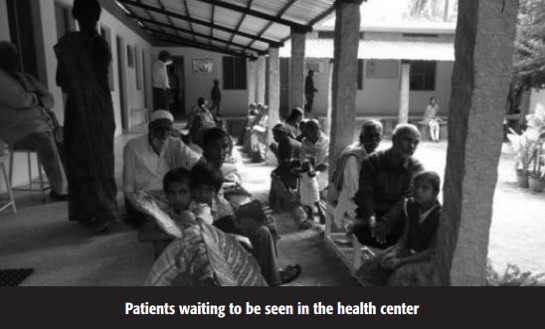
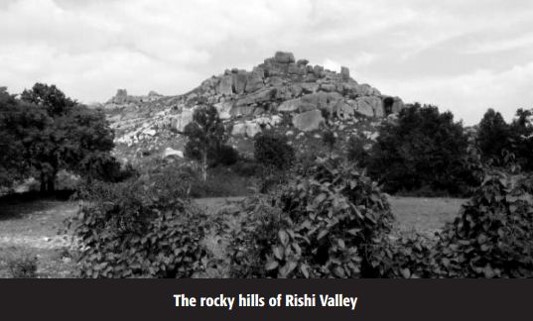
Team Asha
Chapters across Asha
Team Asha is Asha for Education’s endurance training program. Many chapters of Asha across the world have a Team Asha program ranging from running and biking to mountain climbing. To know more about Team Asha, see here.
Spirit of Team Asha
Rajeev Char, Team Asha Silicon Valley Coach
Just a short rhyme for the time!
Remember April?
‘Twas not too long ago,
When even a mile was too far to go!
May, we clamored past those miles,
Worked on strength and our smiles!
June, we are a stronger bunch, aren’t we?
We look at the chart & say, “5 miles…EASY!”
Team Asha UIUC
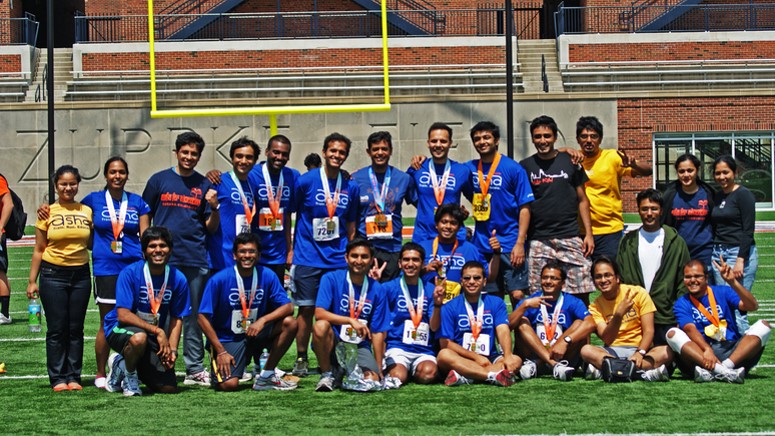
Team Asha had 18 runners who successfully finished the Illinois Marathon 2011. Having trained through months of intense cold, the team came out triumphant on 30 April 2011. While our runners repeatedly perform astonishing feats to spread awareness for Asha for Education, they seek your support to help educate underprivileged children. Congratulations Team Asha!
Team Asha – My Surprising Journey
Heather Seemuth-Johnson, Asha Seattle
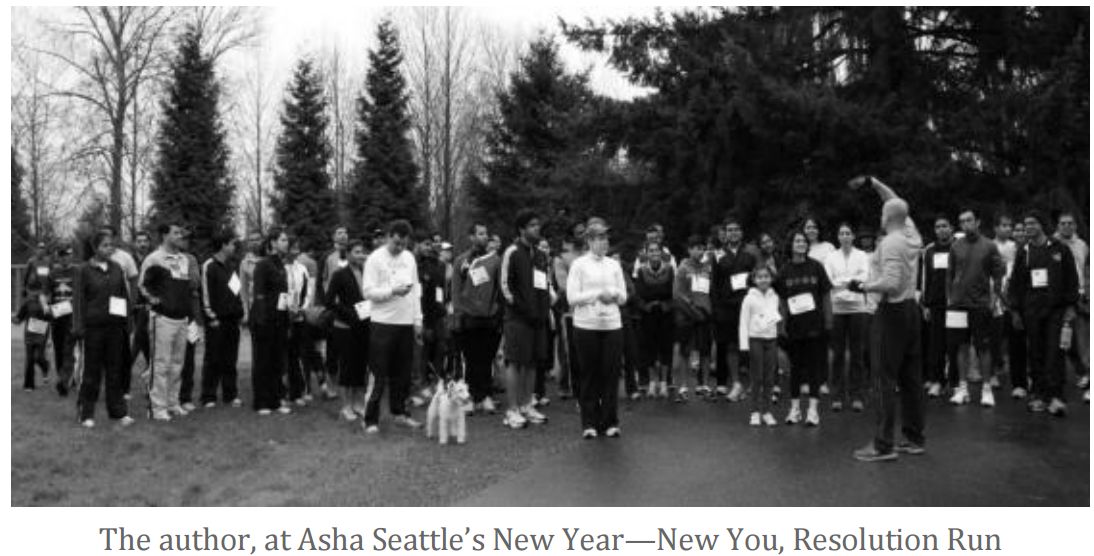
At the end of January, I was struggling to find motivation. I was finding work busier after the holidays. The gym was packed. I was finding it challenging to continue dragging myself outside in the cold, dark & rainy Seattle weather. I felt like I needed to do something! I was already considering trying to run the Rock n’ Roll half marathon in June ─ despite my complete lack of training thanks to the “subtle” encouragement from a good friend.
So, here I was debating what to do to get my act in gear… and then I stumbled upon a flyer for Asha’s “New Year-New You, Resolution Run” at Marymoor Park. It was a free event, that welcomed all levels of runners, and it sounded like it would be a fun gathering of people. I had run some in the past but not more than a few very slow miles. I’ll admit I was slightly intimidated of going, both because mostly I wasn’t sure I could run the whole distance (and what if everyone else could?!) and because I’m not a part of the Indian culture (would I be welcomed and fit-in okay?).
(But) I didn’t have any other plans. So, why not? Maybe it would be just the push I needed. I got to the park and saw a fairly large group gathering for the run. It was easy to locate and luckily the weather wasn’t too bad either. There were plenty of men, women, some children and even a dog or two. I was relieved to see people of varying degrees of fitness. Everyone was incredibly friendly and welcoming. I had a great time on that first run. I was motivated by all the other people around me. Everyone was wonderful at supporting & cheering each other on. I was ecstatic to find others, who like me, had similar goals ─ the Rock n’ Roll Half Marathon. I got to learn about Asha for Education and the “Team Asha” program. I liked being able to get information on the “Team Asha” program and meet the group running coach, Ben Rixe, without feeling pressured.
I was incredibly impressed that Asha for Education is a 100% volunteer organization. They are able to do so much good for people who really need the help. I was impressed by how they select projects and the follow-up that occurs to ensure accountability/progress is made with the money given to projects. I loved that the “Team Asha” program is one of the ways they raise donations to fund these valuable projects. It has been an interesting journey so far and I’m not done yet. Race day is a month away. I am both nervous and excited for the big day. I am less nervous knowing that I will be joined by so many other wonderful Team Asha runners and that together we are raising money for such a worthwhile organization.
April 2011: Today I surprised myself. A lot! Before I go into that…. I am set to run my first half marathon in June (Seattle Rock n’ Roll). Unfortunately, I haven’t run at all in the last month – zero, zilch, nada – as I’ve been nursing a pulled muscle. If I’m being honest, I’ve only managed a few miles over the last two months as I managed to pull it twice. So I’ve missed a lot of training time and had only made it up to ~3.5/4 miles. The repeat injuries had me down & got me thinking that there was no way I would be able to actually run the full race — and that was my goal, to run it. I even thought about throwing in the towel on the race altogether. My running group does their long runs on Sundays. So today, despite the fact that I’m still recovering from the flu, I got my sorry self out of bed. Time to get back on the horse.
Coach, knowing I haven’t been running, calmly reassured me that he can provide a training plan and I have enough weeks to still run the half. “Run? Really?!” I was ecstatic!! I couldn’t believe my dream was still possible!! Then he assigned me my goal miles for today: 5 miles. My heart skipped a beat when I heard him. 5? 5?! I’ve only ever run 5 miles once – in January. Quite possibly in my entire life. That one time was a fluke!! One of those rare days you feel so good that you feel like you could run forever. And that was when I was healthy too. Not when I was recovering from being sick AND not when I was coming back from an injury. All this went through my head in a split second. I never uttered a peep of complaint or exhibited any doubt. Okay.
5 miles it is! I put on my headphones and just got to work. I counted my laps (1/2 mile = 1 lap), but I didn’t think about the miles. I focused on the moment and the joy of running. I took notice of the beautiful park around me: the flowers that were starting to bloom, other runners, people with dogs, and ducks happily foraging for food. I didn’t worry about my time or “oh my god how am I going to survive running X more miles”. And I did it. I completed my miles. I wasn’t dying; heck I wasn’t even panting too hard. I felt like I could have even run further (although I was glad to stop at 5 miles for my hip).
One of the miles was timed by the coach. I was expecting it to read ~13 min. Nope! It was 11 min. I surprised myself by being able to run the 5 miles. I surprised myself with an 11 min/mile. But today it was about a larger moment than that for me. I surprised myself by being stronger than I thought myself capable of being. As the laps ticked by, I thought: “Wow – I can do this!!” and by this I meant the half-marathon. I tend to fight a nagging core belief that I am a weak person. However, usually once I set & focus-in on a specific goal I can just ignore it. I hadn’t realized that this whole time I had believed I actually couldn’t do it; that it wasn’t possible for me to do it. Today I got to feel the strength I have inside. I got a glimpse that I possess greater strength than I can imagine. This IS possible! I know the moment won’t last but I’ll try to carry it with me as long as I can. And in the meantime, I’ll enjoy running. No matter what happens from here… 🙂
For those who can, please consider a donation to help the underprivileged. Running 13.1 miles is nothing compared to the struggles they face every day. I hope some of you will consider joining Team Asha. It doesn’t matter what your endurance level is and you’ll feel supported the whole way!!
Akshardeep
Shreya Paliwal, Asha Zurich
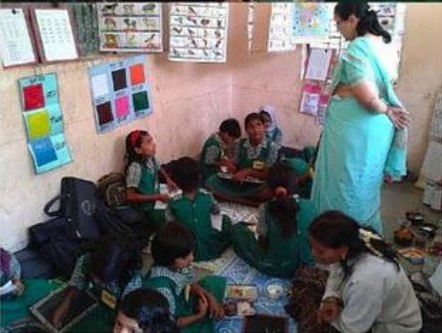
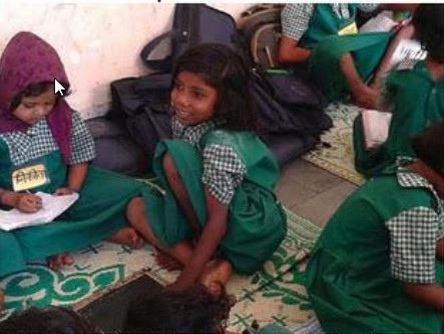
Akshardeep was started by an organization called Swadhar in 1998. It is an alternative school (non-formal education or NFE) program for 6 to 12-year-old children. It runs 10 classes in Pune Municipal Corporation and 10 classes in Pimpri Chinchwad Municipal Corporation. Asha Zurich funds the 10 classes in the PCMC area.
Objectives: Since its inception, the project has been working towards educating children of migrant workers and sex workers and preparing them for mainstream government schools. The teachers come from the same community. School timings and teaching methods are innovative and sufficiently flexible to cater to the educational needs of children coming from varying economically challenged backgrounds. The curricula are based on the State Department of Education curricula but are taught differently, making it more enjoyable and easy to learn.
The Right to Education (RTE) act has changed the role of organizations working in the area of primary education but Akshardeep appears to have made a seamless transition into this new reality. In response to the RTE Act, they have developed methods to help older, illiterate children to quickly come up to speed with the curricula in higher classes. Overall, Akshardeep has done a good job in keeping up with the requirements of the times and has reinvented itself to provide valuable services that help retain students in school.
Year 2011: Currently, 301 children are enrolled in the NFE and support classes. In July-September, we conducted a detailed survey of out-of-school children in two phases. It showed that the number of children going to mainstream school had increased. So we reduced the number of “setu” (bridge) classes. Setu classes are conducted in two areas where there are still out-of-school 6 to 14-year-olds.
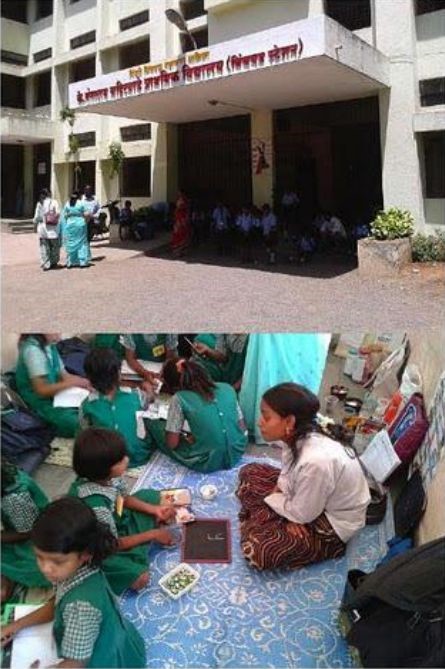
On the other hand, the survey showed an emerging need for support classes for children going to mainstream schools. During the year 116 children were mainstreamed. Unfortunately, 28 dropped out. More support classes may help reduce the number of drop-outs in coming years. Support classes are conducted in two sessions of two hours each for 1st to 4th graders. They help children understand the basic concepts of language and math and improve their performance in school. Basic concepts are strengthened using practical teaching aids. A test to assess a child’s level is conducted on its admission to a support class. If it is older than the appropriate age of the class it is admitted to, it is helped to achieve the critical competencies to reach its age-appropriate level.
We also found a large number of 3 to 6-year-olds needing some form of education. We started balwadis for them. Our expert, Prof Sushma Sathaye of SNDT University, conducted teachers’ training programs on methods of teaching in balwadis. These sessions showed our teachers how everyday objects like flowers can be used to teach pre-reading, writing and math readiness skills. We now have 13 kits containing colorful and attractive teaching aids developed by the teachers. Children enjoy playing and interacting with these aids and thereby absorb related concepts easily.
Incentives for children: As part of the nutrition program, the children are given a snack of sprouts with rice or bread. A protein supplement of ladoos and dry snacks is also provided. From the survey conducted in the beginning of the year Akshardeep found that 10 children, mostly in the 2 to 4-year age group, were suffering from malnutrition. The field workers contacted the balwadi worker of the area and informed her about these children. The children were given protein supplements at the classes. The field workers contacted the children’s mothers too and explained how to give their children necessary nutrition at low cost. These children have since shown good progress in their health.
Various cultural and social events like traditional Bhondla party, Dassera and Diwali party were organized for the children and teachers to help them bond with each other. These events refresh and entertain them and, in turn, motivate them to keep coming to the classes.
Plans: Akshardeep will continue to facilitate more and more children to be mainstreamed and to be retained in mainstream education. We also plan to reach out to the 0-3 and 3-6 year age groups by starting balwadis and intervening in the anganwadi programs where possible.
Karaoke Event
Asha Danbury
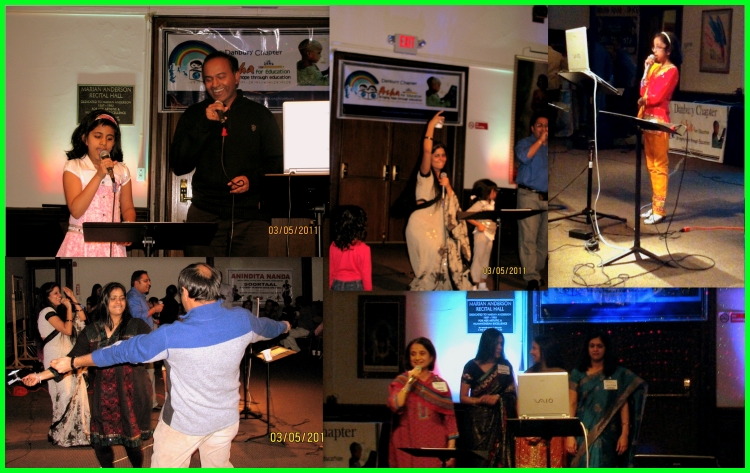
Asha Danbury organized a karaoke event on 5 March 2011 in the Danbury Music Center. The purpose of our chapter’s first fundraiser was to introduce Asha and its mission to the Indian community in Western Connecticut. We briefly described our projects, introduced our team and emphasized the role of volunteerism within Asha. We also invited our chapter mentor, Dr Hitten Zaveri, a researcher from Yale University, to share his experience of volunteering with Asha’s Yale chapter for over ten years.
Given the small scale of this fundraiser, we are particularly grateful to “mYusic”, a group of enthusiastic and very talented singers, for taking the initiative to lead the karaoke for us. They travel in the Tri-state area and not only have a ton of fun doing what they do, but also raise funds to help causes such as disaster relief.
Anindita and Lalitha opened with “Dil hai chotasa, choti si asha.” The karaoke band took us back to the times of Hemant Kumar and Rafi while engaging the audience with more recent movie hits. A number of singers from the Danbury area also signed up to sing their favorites.
We want to thank those who attended the fundraiser as well as donated to our chapter!
Balia Gram Unnayan Samity
A site visit report by Monalisa Sen, Asha UIUC
Project Scope
7 preprimary schools in 10 villages for 303 children (Age: 3-6)
Learning & teaching material
Teachers’ salaries
Provides mid-day meals to all students
Coaching for 260 children (1st-8th grades)
Book bank for 400 students (Age: 15+)
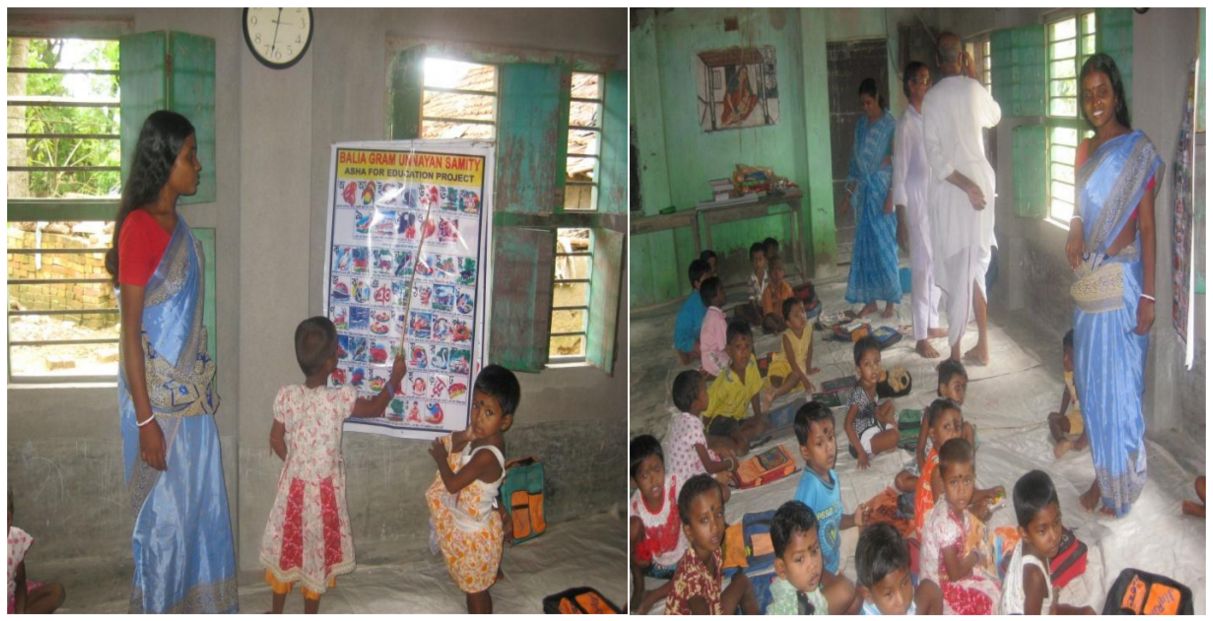
Balia Gram Unnayan Samity (BGUS) is an NGO working in the Hooghly district of West Bengal for the social and educational upliftment of the villagers. BGUS runs pre-primary schools and coaching centers at seven villages. These aim to improve quality of education, prevent early dropout by instilling school going habits in children (through pre-primary schools) and providing supplementary support to students attending government schools (through a coaching program). BGUS also runs a book bank and supports development activities relating to healthcare, farming practices, professional training, etc.
Significance: Children need a friendly and accessible induction to education and schooling in a rural area that has a 30% literacy rate and no tradition of school-going. Without pre-primary education and preparation, a number of children find the step-up to government primary schools insurmountable. A large proportion of these children have illiterate parents who are unable to prepare them for primary school. This is where BGUS’s pre-primary schools step in.
Similarly, the coaching program helps students from economically weaker sections of society cope with school work and compete with students from affluent families who can afford private tuitions or have educated parents to help them with their school work.
BGUS’s book bank lends textbooks for the academic year and has reference books. This program is very popular and benefits students even outside the project area of BGUS. When I visited BGUS, I found the book bank, library and reading room in good condition although I did not meet any library member. Notably, a few pre-primary teachers from the neighborhood who had benefited from the book bank and BGUS were now working with BGUS.
Site Visit: On July 15 this year, my parents and I visited all the schools run by BGUS. I provide a detailed description of my visit to each school below. Overall, I would like to stress that I was overwhelmed by the dedication and continuous effort of the teachers and staff. For instance, they were very particular with documents, e.g., gradebooks, audit books, nutrition & growth monitor charts: Teachers at Balia and Kashipur readily showed me up-to-date books, attendance copies and growth charts. The teachers encouraged local participation, especially from children’s mothers. Their collaborative effort with the mothers in continuing pre-primary schools and mid-day meals was remarkable. Due to funding constraints, BGUS could not pay them market-rate salaries but that did not limit their unceasing dedication to the poor children.
I should also mention that BGUS schools need a lot of renovation and repair. Four of seven buildings were in deplorable condition; all schools’ toilets needed reconstruction and most schools needed water tube-wells. BGUS is completely dependent on Asha UIUC and we have only been able to cover running costs of three programs. We are trying our best to obtain external funds for reconstruction.
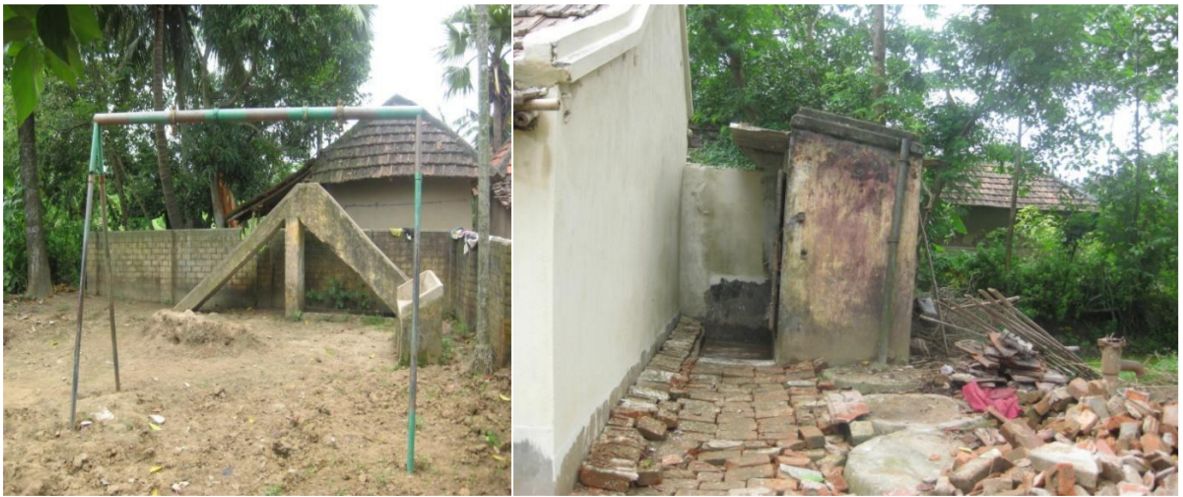
Balia: I reached Balia village around 11.30 am and went to the Balia pre-primary school immediately. The children brought flowers from home to greet me. Some mothers were also present. The children recited poems in English and Bengali and did quick addition and subtraction. The KG II kids sang an entire Rabindrasangeet. Some enacted Bengali poems.
The teachers knew which kids were absent. They also showed me the growth charts and attendance books. The mothers were quite happy that kids were going to school. There was no malnourished kid. However, the toilet and playground were in dreadful condition. Also, a pond behind the school needed to be fenced for the children’s safety.
Kashipur: After Balia, I went to Kashipur. There was only one room and the balcony for three classes (nursery, KG I and KG II). The walls had cracks and there was a hole in the roof. The toilet and playground could not be used by children at all. Conversely, the children were all properly nourished though some mothers requested reviving the tiffin BGUS provided earlier. (Note: We started nutrition programs in August. The site was visited in July.) The kids recited poems for me and were very jolly.
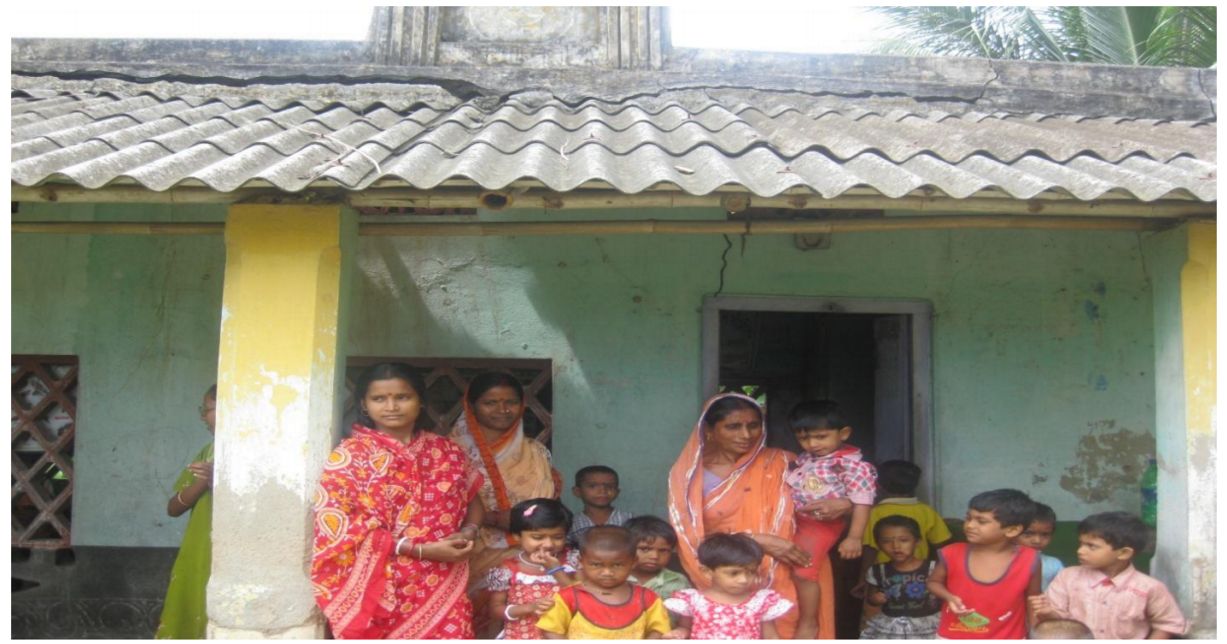
Narayanpur: We reached Narayanpur around 1.30 pm. Most mothers had taken their kids home but brought them back to the school when we got there. The headmaster (an elderly person who oversees the welfare of the area along with Mr Chakraborty) scolded them for taking their kids home before 2 pm. But I understood that since the school no longer provided lunch, the kids got hungry by 2 pm; so, most mothers took them home for food.
The condition of the school was terrible. Walls were cracked and roofs collapsed. Class could be held in the balcony. Of the two rooms, only one was used for teaching but there too the walls were cracked. The other room was used to store tiles that have fallen off the roof. These may be stolen if kept outside.
Mothers do not send children to school when it rains heavily because they fear that the walls might collapse… which is quite possible. Two days before my visit there was a storm and one of the pillars crashed totally. Needless to say, that there was no working tube-well anywhere near, no fence around the pond and no playground. The toys were very old and mostly broken. The condition of the village was no better. It was a village of weavers and though their art was much valued in the city, they did not get much from middlemen.
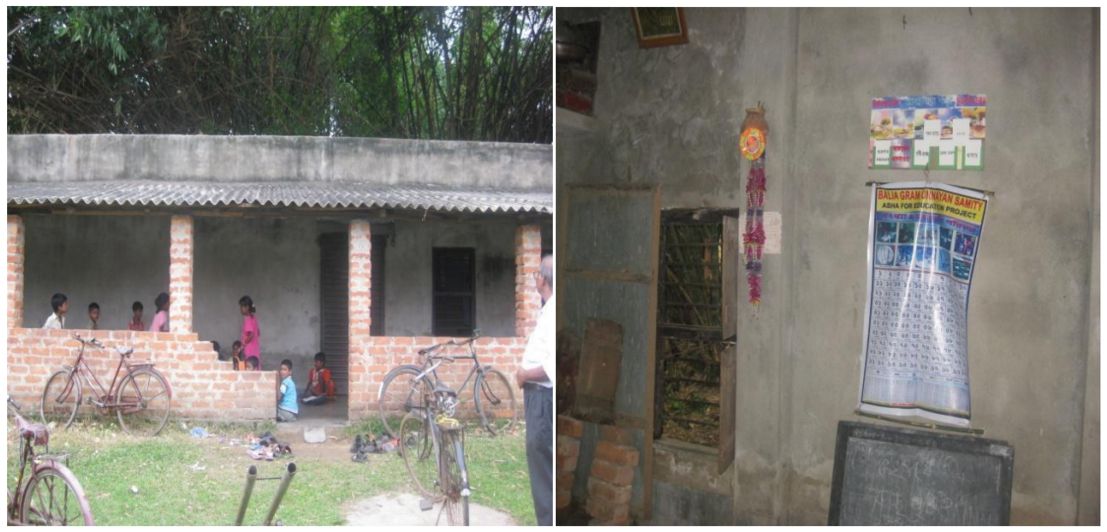
I visited the other four schools just to see the conditions. I could not meet the kids as it was past 2 pm.
Jigra: The school was in good condition as it was reconstructed in 2008-9 using WAH (Work an Hour program) funds. Thus, they were able to increase the number of students. However, the playground was as bad as the other schools’.
Icchapur: The school did not have electricity. They had just a room and the balcony for classes. The roof tiles were old and during the monsoon water leaked into the classroom. The toilets and playground were unusable by children. The cycles for children were very old and rusted.
Bahirkand: There is no electricity in the school building. There is a pole nearby but to get electricity to the school at least two more poles have to be built. This may involve some cost but it is very much doable if BGUS gets some additional funds. The school had a small room with charts and books. There was no water supply nor a proper toilet. The toys were all rusted, old and broken.
When I reached, a coaching class was in progress. The children were very excited to see me. I met a girl in 8th grade who has been with BGUS since pre-primary. The coaching classes had to be held early in the evening as there was no electricity. They could study only as long as there was daylight. Nonetheless, children’s parents expressed their sincere gratitude to all donors of Asha for they could not afford educating their children by themselves.
Dulla: The last school I visited was at Dulla. It was quite far from the other schools. Its condition was deplorable. The roof had collapsed, walls cracked, there were no window panes, no electricity, no bathroom and toys were broken. Some parents said they benefited from the school but were very concerned about the safety of their children, which was only normal given the poor condition of the school.
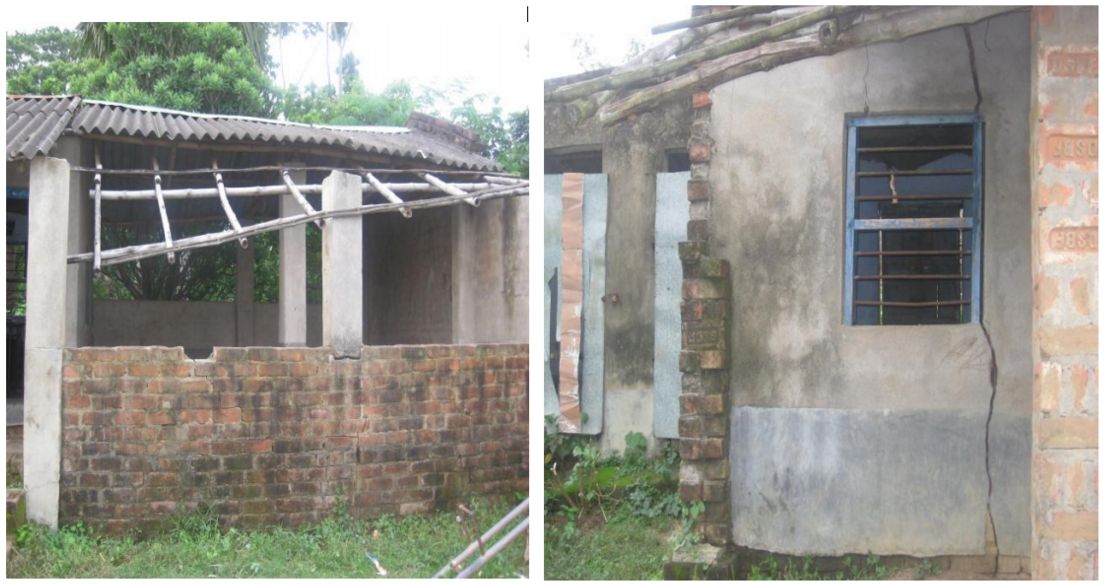
Summing up: The areas where BGUS has schools are poor. Thus, initiatives taken by BGUS are beneficial. The government schools in these areas prefer to enroll children from BUGS’s pre-primary schools as they get a good education and can follow the curriculum in primary schools. Fortunately, the teachers are very concerned for the schools and the children.
All three programs of BGUS are dependent on Asha UIUC for funds. So far we have been able to cover only running cost. However, we should seriously think about a reconstruction plan for the classrooms, playgrounds, toilets and water supply. Quality of education cannot improve much without these basic facilities. As I described, in some schools the condition is so bad that it really raises concerns for the children’s safety. We should also think of nutrition for the children, especially in villages like Dulla, Bahirkand, Narayanpur and Icchapur. We hope our donor community can help us improve the situation.
Quality of Education
Chandan Dasgupta, Asha Chicago and Praveen Gopalakrishnan, Asha CNJ
Background: The Quality of Education (QED) focus group at Asha for Education was formed in 2010. It aims to explore the meaning of quality education, to encourage our project partners to think about ways of improving their pedagogy and forge closer collaboration between Asha and our project partners working on the ground. While (a) Asha volunteers will gain deeper understanding of the complexities and ambiguities of working in the community, (b) project partners will reflect on innovative ways of improving pedagogy. It was also felt that providing a nominal seed funding to the project partners through this QED focus group would help implement innovative ideas. Once implemented, these ideas would be sustained through regular funding from Asha chapters.
After a detailed deliberation involving Asha volunteers, subject experts and project partners, the group came up with nine dimensions comprehensively encompassing QED:
- self-awareness of school aims and objectives
- scholastic learning
- non-scholastic learning
- society
- parents
- teachers
- learner/student
- school management/leadership
- relationship among entities.
Process: With these objectives in mind, the QED group created a detailed questionnaire that helped volunteers dive into the unique projects and gain a holistic understanding of the dynamics of projects. The National Curriculum Framework (NCF), published by the National Council of Educational Research and Training (NCERT) in India, influenced the questions in the questionnaire. The questionnaire covered various pertinent subjects like composition of the administrative staff, the academic environment, ethos of the project, use of educational materials, nature of learning, evaluation techniques and relationships between students, parents and teachers.
Project partners also submitted proposals explaining specific ideas that they wanted to implement for improving quality of education in their projects and potential impacts of these on local communities. In this, they were helped by individual Asha chapters supporting their respective projects. After this, the QED group deliberated over these documents and held discussions with project partners to get clarifications and further inputs on the proposals. The group members shared insights and worked with project partners to refine proposals.
Enactment: In the first phase, the QED group helped implement ideas for improving QED across 19 projects in various parts of the country including Sunderbans, Balia (West Bengal), Kamalpur (Bihar), Chitradurga (Karnataka), Ahmedabad (Gujarat), Dharmapuri (Tamil Nadu), Delhi and Andhra Pradesh. The ideas ranged from creating role-play-based learning environments for fostering creativity and improving English language learning to supplementing homework with audio (developed by professional linguists) that reinforced the curricular units and presented content in multiple ways. Teacher training and professional development of the staff also emerged as an important theme across proposals.
Next steps: After the initial phase, discussions and feedback from the Asha-wide community helped the QED group reposition itself as a knowledge sharing and learning group. It was felt that the real value of the group lay in priming project partners to think about QED and then facilitating cross-pollination of ideas between different projects. While providing seed funds to implement those ideas was a critical piece of the QED jigsaw, starting with implementation in mind often clouds the deliberation process at the proposal stage.
The first phase also helped the QED group realize core competencies of various projects supported by Asha. These competencies needed to be nurtured and developed into more structured offerings to facilitate efficient cross-pollination of ideas and utilization of expertise between projects. This led to the identification of three core themes for the group, namely: (a) identify and support Centers of Excellence among projects covering diverse QED topics, (b) create and support networking initiatives across project partners by leveraging established knowledge sharing platforms and organizing conferences in India whenever possible and (c) provide a learning platform for Asha volunteers by curating resources related to QED and periodically inviting external speakers to share their expertise. The group must address assessments too, so that we understand the effects of any change in the pedagogy. Volunteers are discussing how assessment tools can be designed to take into account socio-economic contexts and highlight the impact of educational innovations on the community connected with each project.
These are some ways in which Asha and its project partners are trying to improve the quality of education in India. While much needs to be done, the QED group seems to be a step in the right direction and may eventually facilitate richer collaboration between Asha and its project partners.
Geetanjali
Asha Seattle
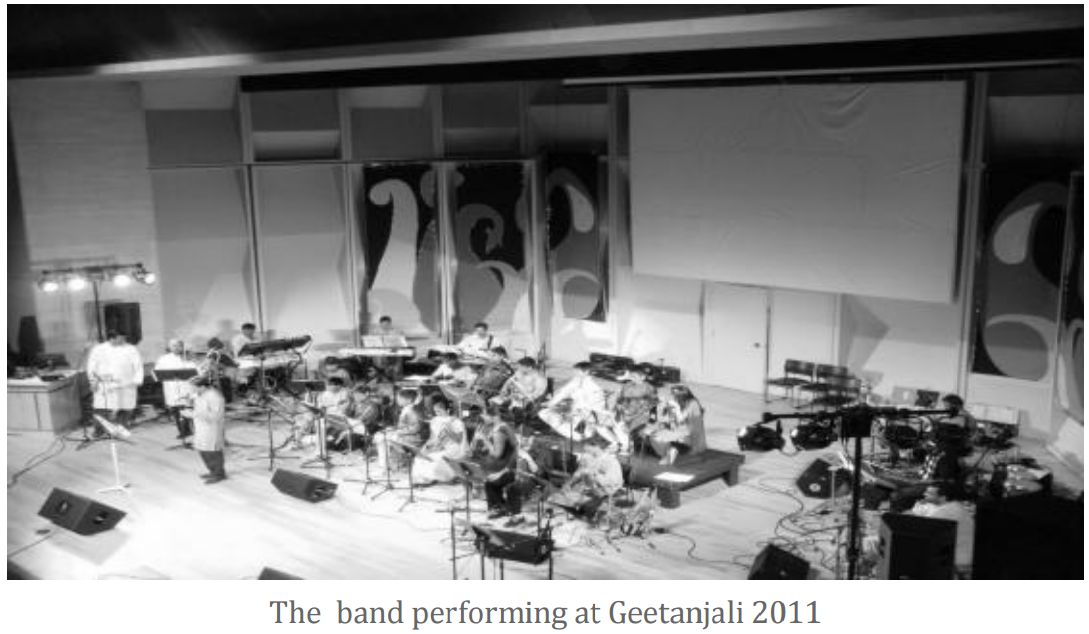
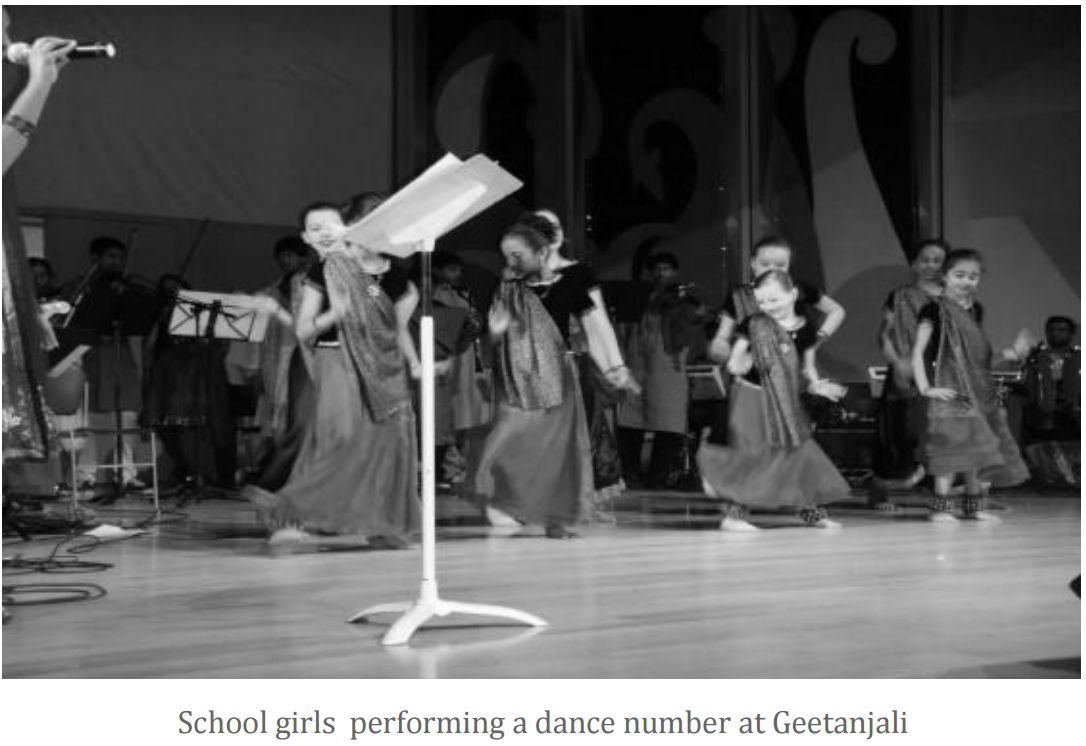
The eighth edition of Asha Seattle’s Tamil music concert, Geetanjali, was held on 9 April 2011 at Kane Hall in the University of Washington. Geetanjali is Puget Sound’s best known Tamil music band composed of local musicians. The band performs for free and its members actively support Asha and other nonprofits. The event was a smash hit, with over 650 attendees who danced to hit Tamil film songs. The event raised close to $14,500. This year’s show featured an orchestra and choreographed dances that were led by children! A CD autographed by AR Rahman was auctioned at this event. We thank our volunteers, the band, Junior Asha and Seattle Tamil Sangam for making this event a grand success.
Financial Reports
Asha-wide Treasury Team
Presented below is a summary of Asha for Education’s finances for the year 2011. Detailed financial reports, including our IRS form 990, can be found here.
Asha-wide Financials
| Heading | Amount |
| Opening Balance | $6,598,198.4 |
| Total Income | $3,569,119.5 |
| Project Disbursements | $2,306,560.5 |
| Total Expenses | $2,917,856.7 |
| Ending Balance | $7,249,461.2 |
Chapter-wise Financials
| Chapter | Opening Balance | Total Income | Total Expenses | Ending Balance | Project Disbursement | ||||
| Ann Arbor | 25,226 | 3,171 | 46 | 28,351 | – | ||||
| Arizona | 191,671 | 39,118 | 10,759 | 220,031 | 10,500 | ||||
| Athens | 6,001 | 6,841 | 5,225 | 7,618 | 5,200 | ||||
| Atlanta | 18,163 | 45,283 | 34,736 | 28,710 | 34,279 | ||||
| Austin | 28,521 | 57,502 | 43,211 | 42,812 | 42,270 | ||||
| Ballia | 4,854 | 25 | 1 | 4,878 | – | ||||
| Bangalore | 16,479 | 32,566 | 27,547 | 21,498 | 26,845 | ||||
| Berkeley | 92,193 | 30,823 | 48,875 | 74,141 | 48,669 | ||||
| Birmingham | 8,177 | 309 | 8,486 | – | – | ||||
| Boston | 158,213 | 67,118 | 74,425 | 150,906 | 74,191 | ||||
| Burlington | 10,877 | – | 10,877 | – | – | ||||
| Canada | 5,146 | 8,109 | 1,300 | 11,955 | 1,200 | ||||
| CFL | 1,287 | 215 | 1,502 | – | – | ||||
| Chennai | 27,824 | 54,108 | 44,771 | 37,160 | 43,621 | ||||
| Chicago | 216,499 | 48,859 | 105,506 | 159,853 | 101,361 | ||||
| Cincinnati | 26,658 | 6,320 | 4,030 | 28,947 | 4,000 | ||||
| Cleveland | 38,132 | 31,960 | 20,550 | 49,541 | 19,650 | ||||
| CNJ | 97,347 | 44,407 | 55,875 | 85,879 | 55,333 | ||||
| Colorado | 79,104 | 2,782 | 6,789 | 75,097 | 6,450 | ||||
| Cornell | 29,074 | 7,705 | 13,255 | 23,524 | 13,200 | ||||
| Corvallis | 18,917 | – | 18,917 | – | – | ||||
| Dallas | 99,012 | 29,362 | 20,249 | 108,125 | 20,001 | ||||
| Danbury | 15 | 5,066 | 2,343 | 2,737 | 2,000 | ||||
| DC | 133,463 | 26,133 | 13,884 | 145,712 | 10,650 | ||||
| Delaware | 22,701 | 3,458 | 65 | 26,093 | – | ||||
| Delhi | 3,840 | 5,134 | 4,204 | 4,770 | 4,150 | ||||
| Detroit | 14,816 | 24,043 | 26,582 | 12,277 | 26,200 | ||||
| Eindhoven | 2,578 | 5 | 0 | 2,583 | – | ||||
| Frankfurt | 2,100 | – | 2,100 | 0 | 2,100 | ||||
| Hartford | 18,787 | 5,663 | 3 | 24,448 | – | ||||
| Houston | 33,596 | 40,104 | 20,342 | 53,358 | 20,319 | ||||
| Hyderabad | 18,128 | 12,188 | 2,557 | 27,759 | 2,350 | ||||
| Irvine | 22,372 | 5,983 | 4,467 | 23,889 | 4,417 | ||||
| Kanpur | 6,398 | 25 | 6,398 | 25 | 6,397 | ||||
| KansasCity | 32,601 | 15,397 | 18,959 | 29,039 | 18,800 | ||||
| Knoxville | 8,867 | 3,723 | 2,534 | 10,056 | 2,500 | ||||
| LA | 47,603 | 5,867 | 4,037 | 49,433 | 4,000 | ||||
| Lalpur | 4,792 | 228 | 7 | 5,013 | – | ||||
| London | 9,967 | 4,653 | 9,279 | 5,340 | 9,254 | ||||
| Lucknow | 5,425 | 20 | 1 | 5,444 | – | ||||
| Madison | 43,085 | 3,513 | 7,032 | 39,567 | 7,030 | ||||
| MHV | 104,743 | 576 | 20,412 | 84,907 | 20,400 | ||||
| Minnesota | 38,903 | 30,021 | 16,235 | 52,689 | 15,423 | ||||
| Mumbai | 10,185 | 5,660 | 70 | 15,775 | – | ||||
| Munich | 4,380 | 3,433 | 3 | 7,810 | – | ||||
| NRV | 5,087 | 5,218 | 2,450 | 7,855 | 2,450 | ||||
| NYCNJ | 595,371 | 115,847 | 188,140 | 523,078 | 173,828 | ||||
| Oxford | – | 3,343 | 0 | 3,343 | – | ||||
| Philly | 32,441 | 13,158 | 33,170 | 12,430 | 33,002 | ||||
| Portland | 23,183 | 4,487 | 14 | 27,657 | – | ||||
| Princeton | 60,043 | 33,623 | 23,095 | 70,572 | 22,824 | ||||
| Pune | 8,719 | 880 | 26 | 9,573 | – | ||||
| Purdue | 13,113 | 6,721 | 6,033 | 13,801 | 6,000 | ||||
| Rajatalab | 146 | 20 | 1 | 165 | – | ||||
| Redlands | 19,450 | 5,172 | 5 | 24,617 | – | ||||
| SB | 22,774 | 750 | 75 | 23,449 | – | ||||
| SD | 46,048 | 22,863 | 11,789 | 57,123 | 11,700 | ||||
| Seattle | 1,032,230 | 779,096 | 620,555 | 1,190,770 | 609,562 | ||||
| SF | 113,499 | 65,407 | 43,252 | 135,654 | 42,012 | ||||
| Sheffield | 1,056 | – | 750 | 306 | 750 | ||||
| SLC | 13,235 | 275 | 1,508 | 12,001 | 1,500 | ||||
| Stamford | 35,929 | 24,156 | 33,664 | 26,421 | 33,250 | ||||
| Stanford | 115,043 | 168,763 | 111,966 | 171,840 | 109,634 | ||||
| StLouis | 28,386 | 39,061 | 16,823 | 50,625 | 16,243 | ||||
| SV | 436,495 | 621,732 | 442,225 | 616,002 | 376,515 | ||||
| Toledo | 31,875 | 65,892 | 12 | 97,755 | – | ||||
| Tsunami | 29,563 | – | 29,563 | – | – | ||||
| Uflorida | 61,365 | 52,122 | 43,632 | 69,855 | 42,600 | ||||
| UIUC | 58,071 | 38,072 | 43,380 | 52,762 | 42,927 | ||||
| Varanasi | 6,307 | 3,373 | 1 | 9,678 | – | ||||
| Wide | 1,988,802 | 767,910 | 533,052 | 2,223,660 | 104,909 | ||||
| Yale | 25,907 | 13,504 | 14,224 | 25,186 | 14,095 | ||||
| Zurich | 5,340 | 200 | 6 | 5,534 | – | ||||
| Total | $6,598,198 | $3,569,120 | $2,917,857 | $7,249,461 | $2,306,561 |
Contact Us
Board of Directors
| President | Ravi Kandikonda | president@ashanet.org |
| Secretary | Raghu Pamidimari | secretary@ashanet.org |
| Treasurer | Akshay Bhole | treasurer@ashanet.org |
| Director, Projects | Padmanava Sen | projects@ashanet.org |
| Director, Fundraising | Anish Johnson | fundraising@ashanet.org |
| Director, Web | Saurabh Madan | webmaster@ashanet.org |
| Director, PR | Alivia Sil | pr@ashanet.org |
Annual Report Team
Suyash Shringarpure, Pradeep Jayaraman and Pabitra Chatterjee
Proofreading by Venkatesh Iyengar.
Thanks to all volunteers who contributed articles, photographs and other content for the Annual Report. We would also like to thank every member of Asha for Education for their valuable inputs and suggestions.
